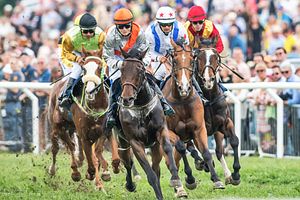Two Saturdays ago saw American Pharoah win the first Triple Crown since Affirmed in 1978. American Pharoah’s success was huge news in the United States, and suggested much about the internationalization of the sport. American Pharoah is owned by Ahmed Zayat, an Egyptian-American, and was rode to victory by Victor Espinoza, first Latino jockey to win the Triple Crown.
Where does East Asia stand in the globalization of horse racing? Few Americans know much about East Asian racing, except for the very few Kentuckians who study the subject intensely. Racing in Japan, South Korea, and especially Hong Kong is taking an ever-larger role in a sport traditionally associated with Kentucky and the Middle East.
Japan is a lucrative center for horse racing, but Japanese racing has suffered, historically, from requirements that horses running in the most important races must be bred in Japan. This isolated Japanese horses from the most productive lineages in the United States and elsewhere. However, because the restrictions apply only to horses bred in Japan, and not to lineages, Japanese money has been able to bring in horses from Kentucky, the Middle East, and Australia to improve the quality of the bloodlines. Most notably, Japanese investors brought in 1989 Kentucky Derby winner Sunday Silence, thereby helping to revolutionize Japanese horse breeding. Sunday Silence was hugely successful as a stud, producing blood lines that have led to competitive horses in Japan, Europe, and the United States.
Indeed, the Japanese horse industry was, for a while, best known in America for the slaughter of Ferdinand, the winner of the 1986 Kentucky Derby. Like Sunday Silence, Ferdinand was sold to Japanese investors, but proved a “dud as a stud.” In 2002 he was unceremoniously slaughtered for food, an act which dismayed many race fans in the United States. The demise of Ferdinand led to an improvement in registration and tracking practices in the equestrian industry worldwide, and also led to the development of contractual provisions for shipping horses back to the United States after their stud days were finished.
Ron Mitchell, editor of Blood-Horse, says that Japanese breeders now play a big role at the major horse sales in the United States, including in Kentucky. “Japanese buyers buy up a lot of American yearlings at Keeneland and other places,” said Mitchell, “Some American breeders now specifically aim for the Japanese market.” Mitchell also said that South Korean money is increasingly present at these sales, even though South Korean racing currently lacks marquee names and races. The South Koreans remain mid-range players (with the Japanese sharing the high end with American and Middle Eastern buyers), but they represent an increasingly important part of the market.
The dog that has yet to bark in East Asian horseracing, so to speak, is China. In China, very old traditions of horse racing fell by the wayside during the Chinese Civil War, and the period of tight Maoist control. Formal restriction on horse racing, and especially on wagering, continue to hobble the industry.
But horse racing is huge in Hong Kong. The equestrian industry in Hong Kong has long-standing connections with the United States, the Middle East, and Europe. It features some of the most heavily capitalized infrastructure in the racing world. According to Mitchell, the racing rules and procedures on Hong Kong, including restrictions on the use of medication and on the ethical treatment of animals, have set the standard for the sport around the world. Among others,
And there seems little question that while horse racing within mainland China remains heavily restricted, Chinese money is finding its ways into racing through the Hong Kong racing community. Chinese buyers now regularly appear in Kentucky and elsewhere, taking advantage of relationships with breeders and ranches in Australia and New Zealand. And if restrictions relax over time, China may occupy an even bigger space in the worldwide industry.
As with many sectors, the equestrian industry is more globally interconnected than it has ever been. There remain important restrictions that prevent the globalization of racing, per se; national governments jealously guard their prerogatives with respect to delaying and impeding the transfer of livestock across borders, making it difficult for the greatest horses from each region to run against one another. Horse breeding, and the intellectual infrastructure necessary to make the horse racing industry work, however, have truly become globalized; Mitchell says that Blood-Horse keeps a close eye on developments in Japan, Hong Kong, and Australia. And there is little question that East Asian fans and breeders will loom large in the future of the sport.
This article is part of a series, written by Kentucky-based Robert Farley, on the links between the U.S. state of Kentucky and the Asia-Pacific. See his previous posts on Kentucky’s bourbon, and car links with the region.

































